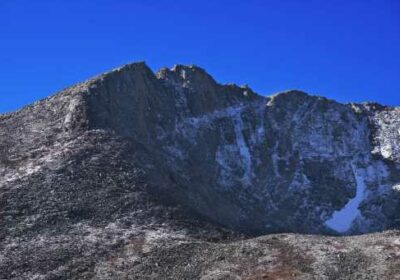Mount Evans is renamed to Mount Blue Sky by U.S. geographic board

Mount Evans, the Colorado fourteener named after the state’s disgraced territorial governor, now has a new name: Mount Blue Sky.
The U.S. Board on Geographic Names voted 15-1 on Friday afternoon to accept the proposal for the new name, which was one of six suggestions for the Front Range peak in Clear Creek County that’s prominently visible from across metro Denver. Three board members abstained.
Territorial Gov. John Evans was forced to resign following the Sand Creek Massacre of 1864, when U.S. soldiers attacked and killed Cheyenne and Arapaho people in southeastern Colorado territory, even after they had tried to broker peace.
Cheyenne and Arapaho Tribes Governor Reggie Wassana called the renaming vote “a huge step” in a statement issued after the vote. Wassana credited several tribes and allied groups “who worked diligently to begin the healing process, bringing honor to a monumental and majestic mountain.”
“We must better face the dark history of the Sand Creek atrocities by honoring the lives that were lost,” added U.S. Sen. John Hickenlooper of Colorado in a statement applauding the decision. “Renaming one of Colorado’s tallest peaks to honor the Arapaho and Cheyenne people is an important step forward.”
The federal board selected Mount Blue Sky, the recommendation put forward by Colorado’s Geographic Names Advisory Board and Gov. Jared Polis. The new name also was backed by the Cheyenne and Arapaho Tribes; the Northern Arapaho Tribe; the Southern Ute Indian Tribe of the Southern Ute Reservation, Colorado; and Ute Mountain Ute Tribe.
The Northern Cheyenne Tribe in Montana opposed the change, saying the name “Mount Blue Sky” could be considered sacrilegious because a Northern Cheyenne ceremony uses the “blue sky” words and concept. The federal vote was delayed in March so the tribes could consult with one another about the disagreement, but they did not reach a consensus.
Though the tribes could not all agree on a single name, they did agree that the current name should be changed.
Other names considered were Mount Rosalie, Mount Soule, Mount Sisty, Mount Cheyenne Arapaho and a final option that would have kept the name as Mount Evans but instead to honor John Evans’ daughter, Anne Evans, a civic and cultural arts leader in Denver.
The goal, advocates of the name change said, was to help tribal members work toward healing and no longer commemorate a man who led efforts to harm their families.
A yearslong name change process culminated in Friday’s vote for Mount Blue Sky. The Arapaho people are known as the “Blue Sky People,” and the Cheyenne people “have an annual ceremony of renewal of life called ‘Blue Sky,’ ” according to the petition submitted by Fred Mosqueda, Arapaho coordinator of the Culture Program of the Cheyenne and Arapaho tribes, and the Wilderness Society.
In January 2020, the Cheyenne and Arapaho Tribes’ legislative branch passed a resolution calling on Congress to rename Mount Evans and the surrounding wilderness area as Blue Sky, according to the petition filed to the Colorado board.
Still unresolved Friday was the fate of the Mount Evans Wilderness. The Cheyenne and Arapaho Tribes called on Congress to adopt the new name for the 74,401-acre expanse.
Colorado’s Geographic Naming Advisory Board was formed in July 2020 amid a renewed public interest in removing symbols of racism, and it has considered a series of name changes for geographic features around the state.
Michael Bennet, Colorado’s other U.S. senator, said Friday afternoon in a news release that the renaming process that resulted in Mount Blue Sky’s new name was a thoughtful one, rightly led by tribal and local communities.
“As we work to address the wrongs done to the Cheyenne & Arapaho Tribes, and to Native people across the country,” Bennet said, “this is a strong first step.”
This is a developing story and will be updated.
Source: Read Full Article